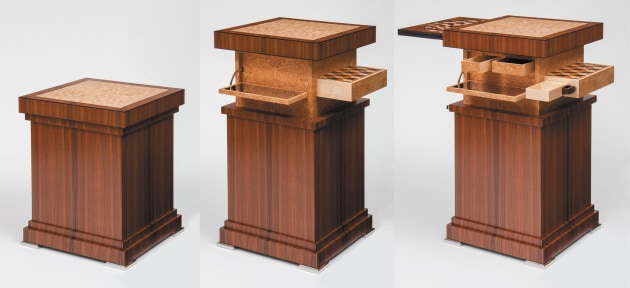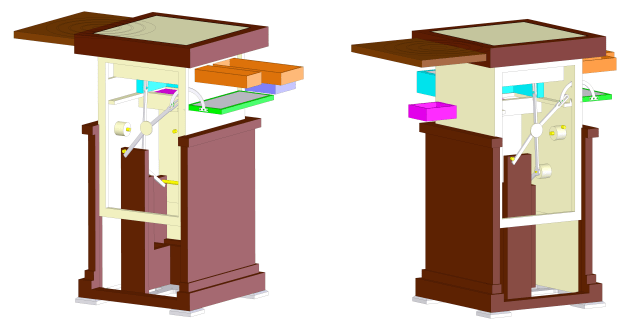Craig Thibodeau's Automoton Table
Craig Thibodeau's Automoton Table: Pressing down on the top triggers rise and fall via the primary gas piston. Steel pins with plastic bushings make contact with pivot arms and as the box rises the arms push the drawer box forward. The pivoting tray is even more complex. Hinged at the base, it pivots around the hinge pins as the curved arm on the side rotates forward.
Words: Linda Nathan
Photos: Craig Carlson
Some years ago, in a radio interview, US maker Craig Thibodeau claimed that he makes to suit his clients’ needs and doesn’t attempt to create heirloom pieces. With the level of intricacy and fine detail his work generally involves however, it’s certain that that’s indeed what he does.
‘If someone came to me and asked for something to last 200 years’, he admits, ‘the only thing I would probably do differently is to use hide glue. Everything else is already done in a way that would last.’

There are nine secret items including a puzzle tray, six drawers (one has a hidden compartment), a magnetic key, and a hinged lid. The cabinet is made of manmade substrate veneered in Brazilian rosewood, quilted maple, maple burl, maple, Gaboon ebony, macassar ebony, and mahogany.
At that time his latest bespoke piece was his Automoton Table with rise and fall top, and a myriad of gas-powered drawers and secret compartments. The look of the table is Art Deco inspired and was made to match in with a piece previously made for the same client.
‘It started out as just a table – initially the client wanted the top to move up and down but then we kept adding functionality to it,’ Craig said. With a background in mechanical engineering and consumer product design, Craig does his design work on the computer. This enabled 3D modelling of components and their movements, allowing for ‘collisions’ and modifying accordingly. Around 200 hours was taken up with the design of this piece alone.
One of Craig Thibodeau's working diagrams for the table
The mechanical movements within the table are inspired by the work of 18th century master furniture makers Abraham and David Roentgen, although Craig considers the Automoton Table to be simple by comparison.

A 21st century touch is the 125lb gas piston mounted on a 1⁄2" thick aluminium plate secured to base of the outer carcase. The top of the piston presses against a series of support arms crisscrossing the interior of the inside box. To hold the mechanism in the down position there is a high load touch latch secured to the inside box and the bottom plate which is rated for 200lbs continuous duty.
The circular table puzzle has five rings of parquetry glued to a three ply veneer backer that is glued to a series of 1/16” thick aluminum rings. These have threaded nuts attached underneath. The rotation is done with five different sized aluminium lazy susans that have been drilled for fasteners going both up into the aluminum rings and down into the wooden framework.
The moving parts are all-wood except for the low-friction custom made 1⁄4" CNC-cut aluminium levers, stainless steel pins and plastic bushings in addition to some off the shelf items.
Designed and made over a six month period, the table took 400 to 500 hours actual build time, with a considerable amount of that occurring in the finetuning stages. The hardest part was ensuring its functionality, allowing for friction and wood movement so parts would open, close and slide smoothly.
Craig works mainly to commission, but also makes a few pieces for Dovetail Collection, a gallery in northern California. You can see the cabinet in action on YouTube, search for CT Fine Furniture. See more of Craig’s work and contact him via his website ctfinefurniture.com




